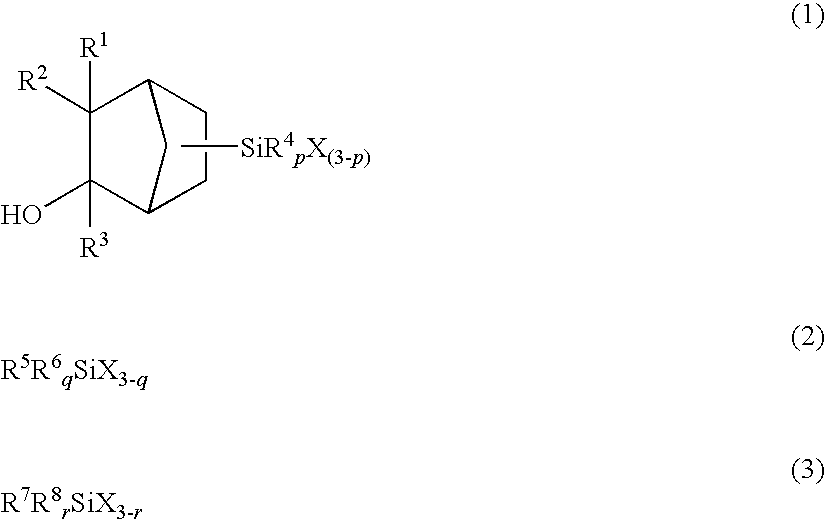Resist composition and patterning process using the same
a composition and resist technology, applied in the field of positive resist compositions, can solve the problems of low resolution performance of resist coating, pattern collapse, polymer undergoes substantial swelling, etc., and achieve the effect of improving resistance to the etching used and forming a pattern
- Summary
- Abstract
- Description
- Claims
- Application Information
AI Technical Summary
Problems solved by technology
Method used
Image
Examples
synthesis example 1
Synthesis of Polymer 1
[0190]A 200-ml four-necked flask equipped with a stirrer, reflux condenser, dropping funnel and thermometer was charged with 0.2 g of acetic acid, 20 g of water, and 20 g of ethanol and kept at 30° C. To the flask, a solution of 10.8 g (30 mmol) Monomer 1, 7.6 g (20 mmol) Monomer 4 and 16.4 g (50 mmol) Monomer 6 in 40 g ethanol was added dropwise over 3 hours. Subsequently the reaction mixture was ripened at 30° C. for 20 hours. The reaction mixture was repeatedly diluted with methyl isobutyl ketone and washed with water until the organic layer became neutral. It was concentrated, obtaining 26.9 g of an oligomer.
[0191]Using 50 g of toluene, the oligomer was transferred to a 100-ml three-necked flask equipped with a stirrer, reflux condenser, and thermometer. Potassium hydroxide, 56 mg, was added to the solution, which was heated under reflux over 20 hours. After cooling, the reaction solution was repeatedly diluted with methyl isobutyl ketone and washed with wa...
synthesis example 2
Synthesis of Polymers 2 to 20
[0194]Silicone resins, designated Polymers 2 to 20, were produced by the same procedure as Synthesis Example 1 using the combination of silane compounds shown in Table 1. The yield and Mw of the polymers are also shown in Table 1.
[0195]
TABLE 1PolymerMonomers used, amountYieldMwPolymer 1Monomer 1Monomer 4Monomer 623.3 g330030 mmol20 mmol50 mmolPolymer 2Monomer 1Monomer 5Monomer 623.0 g340030 mmol20 mmol50 mmolPolymer 3Monomer 1Monomer 4Monomer 724.1 g235030 mmol30 mmol40 mmolPolymer 4Monomer 1Monomer 4Monomer 6Monomer 723.4 g260030 mmol20 mmol25 mmol25 mmolPolymer 5Monomer 2Monomer 4Monomer 624.0 g350020 mmol20 mmol60 mmolPolymer 6Monomer 3Monomer 4Monomer 624.1 g345025 mmol20 mmol55 mmolPolymer 7Monomer 1Monomer 4Monomer 821.8 g355025 mmol15 mmol60 mmolPolymer 8Monomer 1Monomer 4Monomer 922.9 g340030 mmol20 mmol50 mmolPolymer 9Monomer 3Monomer 4Monomer 823.5 g320025 mmol20 mmol55 mmolPolymer 10Monomer 3Monomer 5Monomer 923.1 g315030 mmol20 mmol50 mmolPol...
PUM
| Property | Measurement | Unit |
|---|---|---|
| mol % | aaaaa | aaaaa |
| temperature | aaaaa | aaaaa |
| thickness | aaaaa | aaaaa |
Abstract
Description
Claims
Application Information
 Login to view more
Login to view more - R&D Engineer
- R&D Manager
- IP Professional
- Industry Leading Data Capabilities
- Powerful AI technology
- Patent DNA Extraction
Browse by: Latest US Patents, China's latest patents, Technical Efficacy Thesaurus, Application Domain, Technology Topic.
© 2024 PatSnap. All rights reserved.Legal|Privacy policy|Modern Slavery Act Transparency Statement|Sitemap



